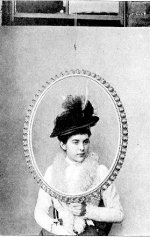Jocko
Off With The Pixies
I recently came across two bound volumes of Amateur Photographer magazine from 1900 and 1901. 107 years ago - yet apart from the 10 ISO “normal” plates, the world these magazines reveal is strangely familiar.
The serious photographer of 1901 was deeply troubled by the threat of film and the end of real photography, Excited articles describe how professionals - particularly newspaper photographers - are using the new hand-held film cameras, dismissed just years before as mere techno-toys. Even worse, the rising generation has no idea of what true photography is. A shocked correspondant reports “at the Bedford Grammar School, large numbers of the boys are film hand-camerarists, wholly unacquainted with stand cameras, plates and the time-honoured processes of the traditional worker”.
Some point out that the new technology has ended the distinction between amateur and professional; newspapers are now printing “snapshootists” photographs, lending a unprecidented immediacy to the news. But the “filmist” approach is essentially mindless: he or she just snaps away, taking unlimited, pointless pictures. The art and craft of the photographer are fast vanishing.
The success of film is even more surprising, given that everyone hates Kodak. Article after article expresses “in no uncertain terms our disapproval of the essentially unengish methods of the Kodak Company, so closely allied to the terrible condition of commercial immorality which has an existence in America””. Kodak are forcing rivals out of business, ceasing production of valued products and deliberately limiting the range of available materials. Photographers are urged to support the new, smaller independent producers.
Then of course, there’s the war - the Boer War. Many features deal with a new breed of front-line photographer, embedded with the troops, using the new film cameras. H.P. Shelley notes that film now has a decisive edge: exposed rolls can be popped in an envelope and whisked home by express mail, bringing the reality of confict to the breakfast table. This naturally leads to controversy as military spokesman denounce “those [blanked] camera fiends with their [blanked blanked] kodaks”.
But perhaps most surprising of all are the repeated tales of police harrassment and public suspicion - “large crowds were awaiting the arrival of the Royal Carriage at Victoria Station when a Lynx-eyed official spotted a camera-man, and he was quietly but firmly informed that snap-shooting was not in season, and, furthermore, he was invited to take a less prominant position in the crowd!”. In an article entitled Cameras are Vulgar, concerning a photographer barred from Kew Gardens, simply on the grounds that photographers are scum, W.R. Bland urges resistance: “Our motto now and henceforth must be “Respect for the camera and ourselves”, and when the year 2001 dawns, but sooner than that, let us hope, the then management of Kew Gardens will not and cannot deny our requests!”
I can’t wait!
Cheers, Ian
You may enjoy this helpful hint for ready-framed portraits.....
The serious photographer of 1901 was deeply troubled by the threat of film and the end of real photography, Excited articles describe how professionals - particularly newspaper photographers - are using the new hand-held film cameras, dismissed just years before as mere techno-toys. Even worse, the rising generation has no idea of what true photography is. A shocked correspondant reports “at the Bedford Grammar School, large numbers of the boys are film hand-camerarists, wholly unacquainted with stand cameras, plates and the time-honoured processes of the traditional worker”.
Some point out that the new technology has ended the distinction between amateur and professional; newspapers are now printing “snapshootists” photographs, lending a unprecidented immediacy to the news. But the “filmist” approach is essentially mindless: he or she just snaps away, taking unlimited, pointless pictures. The art and craft of the photographer are fast vanishing.
The success of film is even more surprising, given that everyone hates Kodak. Article after article expresses “in no uncertain terms our disapproval of the essentially unengish methods of the Kodak Company, so closely allied to the terrible condition of commercial immorality which has an existence in America””. Kodak are forcing rivals out of business, ceasing production of valued products and deliberately limiting the range of available materials. Photographers are urged to support the new, smaller independent producers.
Then of course, there’s the war - the Boer War. Many features deal with a new breed of front-line photographer, embedded with the troops, using the new film cameras. H.P. Shelley notes that film now has a decisive edge: exposed rolls can be popped in an envelope and whisked home by express mail, bringing the reality of confict to the breakfast table. This naturally leads to controversy as military spokesman denounce “those [blanked] camera fiends with their [blanked blanked] kodaks”.
But perhaps most surprising of all are the repeated tales of police harrassment and public suspicion - “large crowds were awaiting the arrival of the Royal Carriage at Victoria Station when a Lynx-eyed official spotted a camera-man, and he was quietly but firmly informed that snap-shooting was not in season, and, furthermore, he was invited to take a less prominant position in the crowd!”. In an article entitled Cameras are Vulgar, concerning a photographer barred from Kew Gardens, simply on the grounds that photographers are scum, W.R. Bland urges resistance: “Our motto now and henceforth must be “Respect for the camera and ourselves”, and when the year 2001 dawns, but sooner than that, let us hope, the then management of Kew Gardens will not and cannot deny our requests!”
I can’t wait!
Cheers, Ian
You may enjoy this helpful hint for ready-framed portraits.....
Attachments
Last edited:


